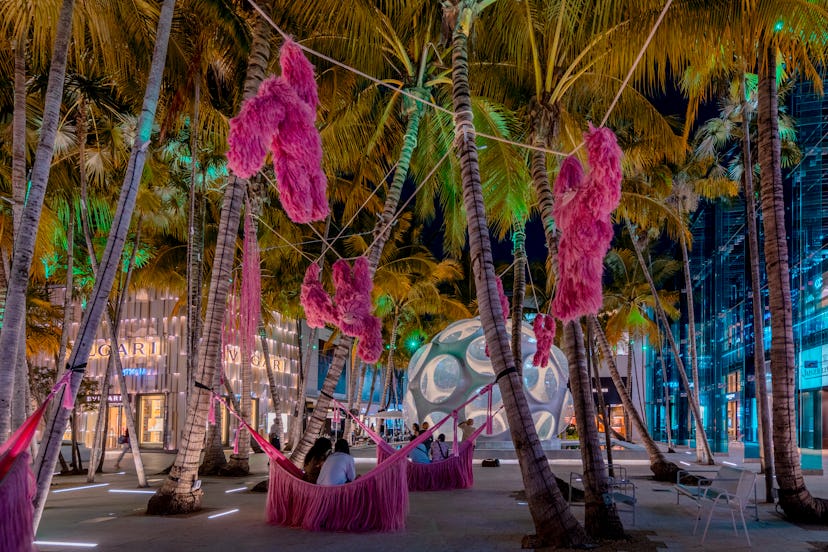Fernando Laposse Brings Shaggy, Chilled-Out Pink Sloth to the Miami Design District

Fernando Laposse has installed a curious, pink-hued troop of fauna across Miami and Miami Beach.
The scene at Design Miami’s opening day this past Tuesday was nothing short of a frenzy, as collectors, journalists, and dealers jostled for access. It was interesting, however, that the first thing they saw upon entering the building was a tableau of totally chilled-out, shaggy pink sloth. Later, as crowds flocked to the bustling Miami Design District for the week’s obligatory tour of exhibitions, cocktail parties, and dinners, they were greeted by the same creatures, except this time they were hanging from trees and accompanied by thousands of pink strands of fabric strung over ten blocks of the neighborhood.
Courtesy of Miami Design District.
Pink Beasts was created by the Mexican product and material designer Fernando Laposse, in collaboration with Angela Damman, who owns a sustainable hacienda in Mexico that produces sisal, a fabric made from the agave plant.
“The idea was that the tassels would guide visitors to the main areas of the installation,” Laposse said. He was referring to the park-like sections of the busy Paseo Ponti, the Design District’s pedestrian thoroughfare, where hammocks were hung alongside the sloth to create surreal tropical settings.
Laposse lives in London and studied at Central Saint Martins, but throughout his career he has focused on bringing to light traditional Mexican craftsmanship techniques that have remained under-recognized on the international scale. Aside from sisal, he has worked with materials such as cornhusk and loofah to create furniture that is as innovative and cosmopolitan as it is sustainable and ecologically sound.
“In countries like Mexico, people grew up thinking that what came from the United States or Europe was always better,” Laposse says. “But the sentiment is changing. We are starting to understand the value of what we have, realizing that there is incredible local knowledge of natural materials and indigenous cultural traditions that are still alive, along with ways of working that are really well suited for our environments. The world is becoming more global, but at the same time there is more appreciation for what is local. For me, sustainability is not just about materials, but about designing for the reality of a place.”
Courtesy of Miami Design District.
For Pink Beasts, about 650 kilograms of string—handmade from about 15,000 plant leaves—were used. The fabric was dyed using cochineal, a tiny insect that has been prized since the time of the Aztecs for its naturally vibrant red color. (The cochineal live exclusively on prickly pear cactuses; Laposse found a collective in Oaxaca that farms the bugs and specializes in natural dyes.) The hammocks, sloth, and banners were then made by artisans in the village of Sacabah, Yucatán.
As sustainability becomes more and more of an imperative in the design community, Laposse is redoubling his efforts to push the conversation to the forefront. Next year, he will travel with some of his craftsmen to Davos, Switzerland to participate in an ecological conference.
Courtesy of Miami Design District.
“Indigenous communities are the ones who contribute the least to global warming, but they are the ones who are affected the most by it,” he says succinctly.
But what of the sloth? What will happen to them once this commission comes to an end? “They belong to the Design District now,” Laposse says. “But I really want to make another edition of them and turn them into lamps. I have a vision of a chandelier made up of sloth holding light domes.” Stay tuned.
Courtesy of Miami Design District.